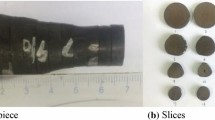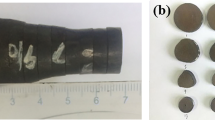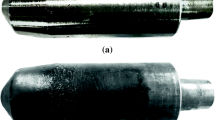Abstract
In order to determine the deformation process window and inquire the cause of internal cracks and voids, three-roll planetary rolling process was modeled by three-dimensional finite element method, and internal cracks and voids were investigated by real rolling of a bismuth-containing austenitic stainless steel bar. It shows that improper process parameters will lead to cracks and voids in the rolled bar. The Brozzo ductile fracture criteria revised can be used to determine the damage factor. The deformation process window to avoid internal cracks and voids can be described by rolling elongation and temperature. The three positive principal stresses in the center of the rolled bar, the alternating stress caused by periodically discontinuous contact between the rolls and the rolled piece, and the uneven radial strain distribution can be counted to be the main reasons for internal cracks and voids in the rolled bar. This study shows that the elongation has an upper limitation for avoiding internal cracks and voids in the bismuth-containing austenitic stainless steel bar rolled by three-roll planetary mill.








Similar content being viewed by others
References
S. Rhode, V. Kain, V.S. Raja, and G.J. Abraham, Factors Affecting Corrosion Behavior of Inclusion Containing Stainless Steels: A Scanning Electrochemical Microscopic Study, Mater. Charact., 2013, 77, p 109–115.
L. Zhuang and W. Di, Effect of Free-Cutting Additives on Machining Characteristics of Austenitic Stainless Steels, J. Mater. Sci. Technol., 2010, 26, p 839–844.
W. Di and L. Zhuang, A New Pb-Free Machinable Austenitic Stainless Steel, J. Iron Steel Res. Int., 2010, 17, p 59–63.
Z. Yongjun, Z. Chen, W. Lifeng, and Z. Huanchun, Development of Free Cutting Steel for Machine Structure without Lead, Mater. Rev., 2005, 19, p 68–71.
D. Mathilde, K. Hyoun-Ee, S. Vladimir, D. Sergey, and E. Yuri, Improving the Mechanical Properties of Pure Magnesium by Three-Roll Planetary Milling, Mater. Sci. Eng. A, 2014, 612, p 287–292.
B. Romantsev, A. Goncharuk, A. Aleshchenko, Y. Gamin, and M. Mintakhanov, Development of Multipass Skew Rolling Technology for Stainless Steel and Alloy Pipes’ Production, Int. J. Adv. Manuf. Technol., 2018, 97, p 3223–3230.
W. Yali, M. Andrey, D. Mathilde, L. Rimma, K. Hyoun-ee, W. Jingtao et al., Gradient Structure Produced by Three Roll Planetary Milling: Numerical Simulation and Microstructural Observations, Mater. Sci. Eng. A, 2015, 639, p 165–172.
F. Yabo, C. Jing, and C. Zhiqiang, Cracks of Cu-Cr-Zr Alloy Bars Under Planetary Rolling, Rare Metal Mater. Eng., 2015, 44, p 567–570.
M.M. Skripalenko, S.P. Galkin, S. Her-Jae, B.A. Romantsev, H. Tran-Ba, M.N. Skripalenko et al., Prediction of Potential Fracturing during Radial-Shear Rolling of Continuously Cast Copper Billets by Means of Computer Simulation, Metallurgist, 2019, 62, p 849–856.
L. Sheng-Zhi, M. Wen-Hua, H. Lan-Wei, and D. Bo, Research on the Tendency of Inner Crack During 3-Roll Skew Rolling Process of Round Billets, Adv. Mater. Res., 2011, 145, p 238–242.
Y.L. Wang, A. Molotnikov, M. Diez, R. Lapovok, H. Kime, J.T. Wang et al., Gradient Structure Produced by Three Roll Planetary Milling: Numerical Simulation and Microstructural Observations, Mater. Sci. Eng. A, 2015, 639, p 165–172.
X. Wenchen, W. He, M. Hao, and S. Debin, Damage Evolution and Ductile Fracture Prediction During Tube Spinning of Titanium Alloy, Int. J. Mech. Sci., 2018, 135, p 226–239.
F. Freudenthal, The Inelastic Behavior of Solids, Wiley, New York, 1950.
M.G. Cockroft and D.J. Latham, Ductile and Workability of Metals, J. Inst. Met., 1968, 96, p 33–39.
P. Brozzo, B. DeLuca, and R. Rendina, A new method for the prediction of formability limits in metal sheets, in Proceedings of the Seventh Biennial Conference of the International Deep Drawing Research Group (1972)
S. Xuedao, L. Guoping, and Z. Wangming, Prediction of the Central Defect Location for Multi-Wedge Cross Wedge Rolling Forming Automobile Semi-Axle, Appl. Sci. Technol., 2012, 39, p 45–48.
F.A. McClintock, A Criterion for Ductile Fracture by the Growing of Holes, J. Appl. Mech., 1968, 35, p 363–371.
J.R. Rice and D.M. Tracey, On the Ductile Enlargement of Voids in Triaxial Stress Fields, J. Mech. Phys. Solids, 1969, 17, p 201–217.
Y. Lou, H. Huh, S. Lim, and K. Pack, New Ductile Fracture Criterion for Prediction of Fracture Forming Limit Diagrams of Sheet Metals, Int. J. Solids Struct., 2012, 49, p 3605–3615.
N. Park, H. Huh, S.J. Lim, Y. Lou, Y.S. Kang, and M.H. Seo, Fracture-based Forming Limit Criteria for Anisotropic Materials in Sheet Metal Forming, Int. J. Plast., 2017, 96, p 1–35.
Y.B. Bao and T. Wierzbicki, On the Cut-Off Value of Negative Triaxiality for Fracture, Eng. Fract. Mech., 2005, 72, p 1049–1069.
S. Basak and S.K. Panda, Failure Strains of Anisotropic Thin Sheet Metals: Experimental Evaluation and Theoretical Prediction, Int. J. Mech. Sci., 2019, 151, p 356–374.
Z. Pater, J. Tomczak, and T. Bulzak, Rotary Compression as a New Calibration Test for Prediction of a Critical Damage Value, J. Mater. Res. Technol., 2020, 9, p 5487–5498.
Z. Pater, J. Tomczak, T. Bulzak, L. Wojcik, and P. Walczuk, Assessment of Ductile Fracture Criteria with Respect to Their Application in the Modeling of Cross Wedge Rolling, J. Mater. Process. Technol., 2020, 278, p 1–11.
Z. Jihua and G. Kezhi, Deformation Resistance of Alloy Structural Steel, J. Univ. Sci. Technol. B, 1986, 4, p 50–56.
Y.-M. Hwang, W.M. Tsai, F.H. Tsai, and I. Her, Analytical and Experimental Study on the Spiral Marks of the Rolled Product During Three-Roll Planetary Rolling Processes, Int. J. Mach. Tool. Manuf., 2006, 46, p 1555–1562.
Wu. Shyue-Jian, Y.-M. Hwang, and M.-H. Chang, A Three-Dimensional Finite Element Analysis of the Three-Roll Planetary Mill, J. Mater. Process. Technol., 2002, 123, p 336–345.
C.-K. Shih and C. Hung, Experimental and Numerical Analyses on Three-Roll Planetary Rolling Process, J. Mater. Process. Technol., 2003, 142, p 702–709.
B. Li, S.H. Zhang, G.L. Zhang, H.Y. Zhang, and H.Q. Zhang, Microstructure Simulation of Copper Tube and Its Application in Three Roll Planetary Rolling, Mater. Sci. Technol., 2007, 23, p 715–722.
S.-D. Hu, Y.-N. Jiang, C. Zhou, L.-X. Li, X.-Y. Wang, and C. Wang, Prediction and Prevention of Cracks in Free-Cutting Stainless Steel Bar Forming, Metall. Mater. Trans. B, 2020, 51B, p 1687–1696.
M. Hao, X. Wenchen, J. BoCheng, S. Debin, and R.N. Steven, Damage Evaluation in Tube Spinnability Test with Ductile Fracture Criteria, Int. J. Mech. Sci., 2015, 100, p 99–111.
S. Dobatkin, S. Galkin, Y. Estrin, V. Serebryany, M. Diez, N. Martynenko et al., Grain Refinement, Texture, and Mechanical Properties of a Magnesium Alloy After Radial-Shear Rolling, J. Alloys Comp., 2019, 774, p 969–979.
P. Montmitonett, P. Gratacos, and R. Ducloux, Application of Anisotropic Viscoplastic Behaviour in 3D Finite-Element Simulations of Hot Rolling, J. Mater. Process. Technol., 1996, 58, p 201–211.
T.K. Akopyan, Y.V. Gamin, S.P. Galkin, A.S. Prosviryakov, A.S. Aleshchenko, M.A. Noshin et al., Radial-Shear Rolling of High-Strength Aluminum Alloys: Finite Element Simulation and Analysis of Microstructure and Mechanical Properties, Mater. Sci. Eng. A, 2020, 786, p 1–10.
Author information
Authors and Affiliations
Corresponding author
Additional information
Publisher's Note
Springer Nature remains neutral with regard to jurisdictional claims in published maps and institutional affiliations.
Rights and permissions
About this article
Cite this article
Li, L., Li, J. & Ye, B. Internal Damage Mechanism and Deformation Process Window of a Free-Cutting Stainless Steel Bar Rolled by Three-Roll Planetary Mill. J. of Materi Eng and Perform 31, 1187–1194 (2022). https://doi.org/10.1007/s11665-021-06234-w
Received:
Revised:
Accepted:
Published:
Issue Date:
DOI: https://doi.org/10.1007/s11665-021-06234-w




